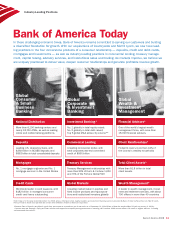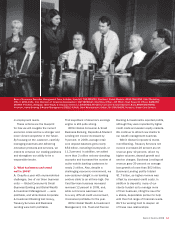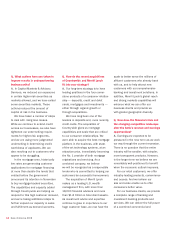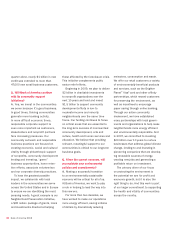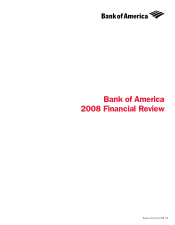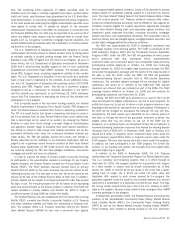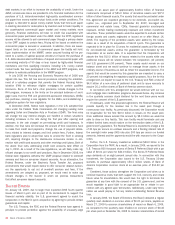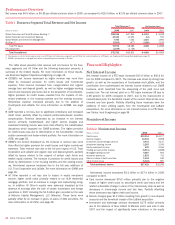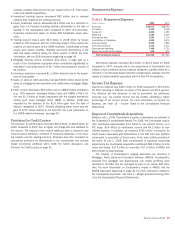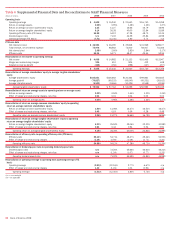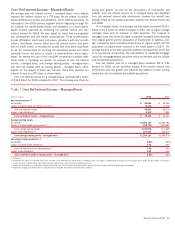Bank of America 2008 Annual Report Download - page 23
Download and view the complete annual report
Please find page 23 of the 2008 Bank of America annual report below. You can navigate through the pages in the report by either clicking on the pages listed below, or by using the keyword search tool below to find specific information within the annual report.year. The underlying credit exposures of eligible securities used for
collateral must be newly or recently originated auto loans, student loans,
credit card loans, small business loans guaranteed by the U.S. Small Busi-
ness Administration, or commercial mortgage-backed securities. Originators
of the credit exposures underlying the eligible asset-backed securities must
have agreed to comply with, or already be subject to, the executive
compensation requirements of the EESA. As announced in connection with
the Financial Stability Plan, the TALF may be expanded to as much as $1.0
trillion and eligible asset classes may be expanded later to include other
assets such as non-agency residential mortgage- backed securities and
assets collateralized by corporate debt. The Corporation is currently evaluat-
ing the terms of this program.
The U.S. Department of Education implemented initiatives to ensure
uninterrupted and timely access to federal student loans by taking steps
to maintain stability in student lending through both the Federal Family
Education Loan (FFEL) Program and the Direct Loan Program. As part of
these efforts, the U.S. Department of Education announced in November
2008 that it would provide liquidity support to one or more conforming
Asset-Backed Commercial Paper (ABCP) conduits. The conduits will pur-
chase FFEL Program loans, providing longer-term stability to the market-
place. The U.S. Department of Education in turn will serve as a potential
buyer of last resort or backstop to the conduits. As an additional meas-
ure, the U.S. Department of Education will purchase certain 2007-2008
academic year FFEL Program loans. This will be a short-term program
designed to act as a mechanism to minimize disruptions in the interim
until the conduits are operational, or until February 28, 2009, whichever
occurs first. The Corporation is evaluating the terms of this initiative and
participation in this program.
Due to liquidity issues in the short-term funding markets, the Federal
Reserve implemented a temporary Term Auction Facility (TAF) program in
which the Federal Reserve auctions term funds to depository institutions.
The TAF is a credit facility that allows a depository institution to place a
bid for an advance from its local Federal Reserve Bank at an interest rate
that is determined as the result of an auction. By allowing the Federal
Reserve to inject term funds through a broader range of counterparties
and against a broader range of collateral than open market operations,
this facility is aimed to help ensure that liquidity provisions can be dis-
seminated efficiently even when the unsecured interbank markets are
under stress. The TAF will typically auction term funds with 28-day or
84-day maturities and is available to all depository institutions that are
judged to be in generally sound financial condition by their local Federal
Reserve Bank. Additionally, all TAF credit must be fully collateralized. We
are currently utilizing the TAF and have pledged residential, commercial
mortgage and credit card loans as collateral.
In order to improve the ability of primary dealers to provide financing
to participants in the securitization markets in exchange for any tri-party-
eligible collateral the Federal Reserve created the Primary Dealer Credit
Facility (PDCF). The PDCF provides discount window loans to primary
dealers that will settle on the same business day and will mature on the
following business day. The rate paid on the loan will be the same as the
primary credit rate at the Federal Reserve Bank of New York. In addition,
primary dealers will be subject to a frequency-based fee after they exceed
45 days of use. The frequency-based fee will be based on an escalating
scale and communicated to the primary dealers in advance. The PDCF will
remain available to primary dealers until October 30, 2009 or longer if
conditions warrant. During 2008 we utilized this facility.
The Federal Reserve has also established the Term Securities Lending
Facility (TSLF), a weekly loan facility, to promote liquidity in U.S. Treasury
and other collateral markets and foster the functioning of financial mar-
kets. The program offers U.S. Treasury securities held by the System
Open Market Account (SOMA) for loan over a one-month term against
other program-eligible general collateral. Loans will be awarded to primary
dealers based on competitive bidding, subject to a minimum fee require-
ment. The Open Market Trading Desk of the Federal Reserve Bank of New
York will auction general U.S. Treasury collateral (treasury bills, notes,
bonds and inflation-indexed securities) held by SOMA for loan against all
collateral currently eligible for tri-party repurchase agreements arranged
by the Open Market Trading Desk and separately against collateral and
investment grade corporate securities, municipal securities, mortgage-
backed securities, and asset-backed securities. The Corporation has uti-
lized this facility and has pledged agency mortgage-backed securities and
private label mortgage-backed securities as collateral.
The FDIC has implemented the TLGP to strengthen confidence and
encourage liquidity in the banking system. The TLGP is comprised of the
Debt Guarantee Program (DGP) and the Transaction Account Guarantee
Program (TAGP). Under the DGP, the FDIC will guarantee all newly issued
senior unsecured debt (e.g., promissory notes, unsubordinated
unsecured notes and commercial paper) up to prescribed limits issued by
participating entities beginning on October 14, 2008 and continuing
through October 31, 2009. For eligible debt issued by that date, the FDIC
will provide the guarantee coverage until the earlier of the maturity date of
the debt or June 30, 2012. Under the TAGP, the FDIC will guarantee
noninterest-bearing deposit accounts held at FDIC-insured depository
institutions. The unlimited deposit coverage will be voluntary for eligible
institutions and would be in addition to the $250,000 FDIC deposit
insurance per account that was included as part of the EESA. The TAGP
coverage became effective on October 14, 2008 and will continue for
participating institutions until December 31, 2009.
Initially, the DGP and TAGP were provided at no cost for the first 30
days and allowed for eligible institutions to opt out of such programs. An
entity that chose not to opt out of either or both programs became a par-
ticipating entity and will be assessed fees for participation. Participants in
the DGP will be charged an annualized fee between 50 and 100 bps,
multiplied by the debt issued, and calculated for the maturity period of
that debt, or through the term of the guarantee, whichever is earlier. Any
eligible entity that has not chosen to opt out of the TAGP will be
assessed, on a quarterly basis, an annualized 10 bps fee on balances in
noninterest-bearing transaction accounts that exceed the existing deposit
insurance limit of $250,000. In December 2008, Bank of America, N.A.
issued $4.3 billion in long-term senior unsecured bank notes while the
parent company issued $15.6 billion in long-term senior notes under the
TLGP program. We have also issued short-term notes under this program.
In addition, we have participated in the TAGP program. For further dis-
cussion on our liquidity and capital, see Liquidity Risk and Capital Man-
agement beginning on page 55.
In addition to the TLGP, in September 2008, the U.S. Treasury
implemented the Temporary Guarantee Program for Money Market Funds.
This is a voluntary and temporary program that is in effect through at
least April 30, 2009. The program provides for a guarantee with respect
to a fixed number of shares held by certain shareholders as of Sep-
tember 19, 2008, to receive $1.00 per share in the event that a partic-
ipating fund no longer has a $1.00 per share net asset value and
liquidates. With respect to such shares covered by the program, the
guarantee payment would be equal to any shortfall between the amount
received by a shareholder in a liquidation and $1.00 per share. The eligi-
ble money market mutual funds pay a fee to the U.S. Treasury to partic-
ipate in the program. Several money market funds managed within GWIM
currently participate in the program.
In September and October 2008, the Federal Reserve announced the
creation of the Asset-Backed Commercial Paper Money Market Mutual
Fund Liquidity Facility (AMLF), the Commercial Paper Funding Facility
(CPFF) as well as the Money Market Investor Funding Facility (MMIFF).
These facilities were created to provide liquidity to the U.S. short-term
Bank of America 2008
21


